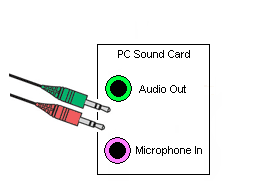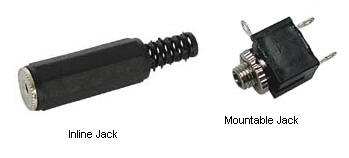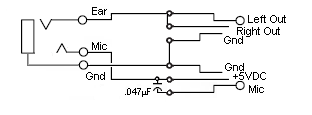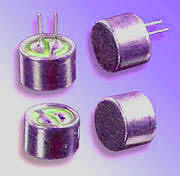Use a Standard Cell Phone Headset With a PC Sound Card for Softphone Applications
The trick is getting the headset to interface with a sound card. The typical sound card has a microphone input and a headset/external speaker output at the very least.
They use 3.5 mm 2 conductor mini phone plugs as seen in Fig 1. The microphone input connections are as follows:
- Tip: Audio
- Ring: +5VDC
- Sleeve: Ground
The audio or "ear" connections are as follows:
- Tip: Left Channel
- Ring: Right Channel
- Sleeve: Ground
See Fig 2 for plug nomenclature.
The headset uses a 2 conductor subminiature 2.5 mm plug as seen in Fig 3. The connections are as follow:
- Tip: Mic
- Ring: Ear
- Sleeve: Ground
To interface these devices, you will need to connect +5VDC from the soundcard to the headset mic and connect the headset mic output to the soundcard mic input using a decoupling capacitor. Some soundcards won't work if you don't remove the DC voltage from the input. Next, combine the left and right audio outputs from the sound card to the ear connection of the headset, then connect all the grounds together. Be sure to use shielded cable between connectors. The 2.5 mm jack can be either an inline one or if you want, use a mountable one and a small enclosure, preferably aluminum to minimize noise pickup. (See Fig 4)
Fig 5 shows the wiring detail.
Below is a key to the schematic symbols.

A digression into electret microphones
The ubiquitous electret microphone is seen in just about every consumer device these days from phones to video cameras, and everything in-between. These devices exploit a material known as an "electret", a word that was derived from "magnet". That's because an electret is to an electric field what a magnet is to a magnetic field. Both are more-or-less permanent and require no infusion of energy to sustain their fields. The electret has a static charge, much like a capacitor, (condenser is the old term for capacitor, but is still used when relating to microphones). This capacitance can be varied by deforming the electret by means of sound pressure waves, and thus be used as a transducer. The signal is very weak requiring amplification, usually accomplished with a FET amplifier built into the module. That is the reason for the 5 volt bias voltage, not to be confused with "phantom voltage" used with professional condenser microphones, which is typically 48VDC,and superimposed on both the hot and cold terminals of the XLR input.

Fig 1

Fig 2

Fig 3

Fig 4

Fig 5

Fig 6